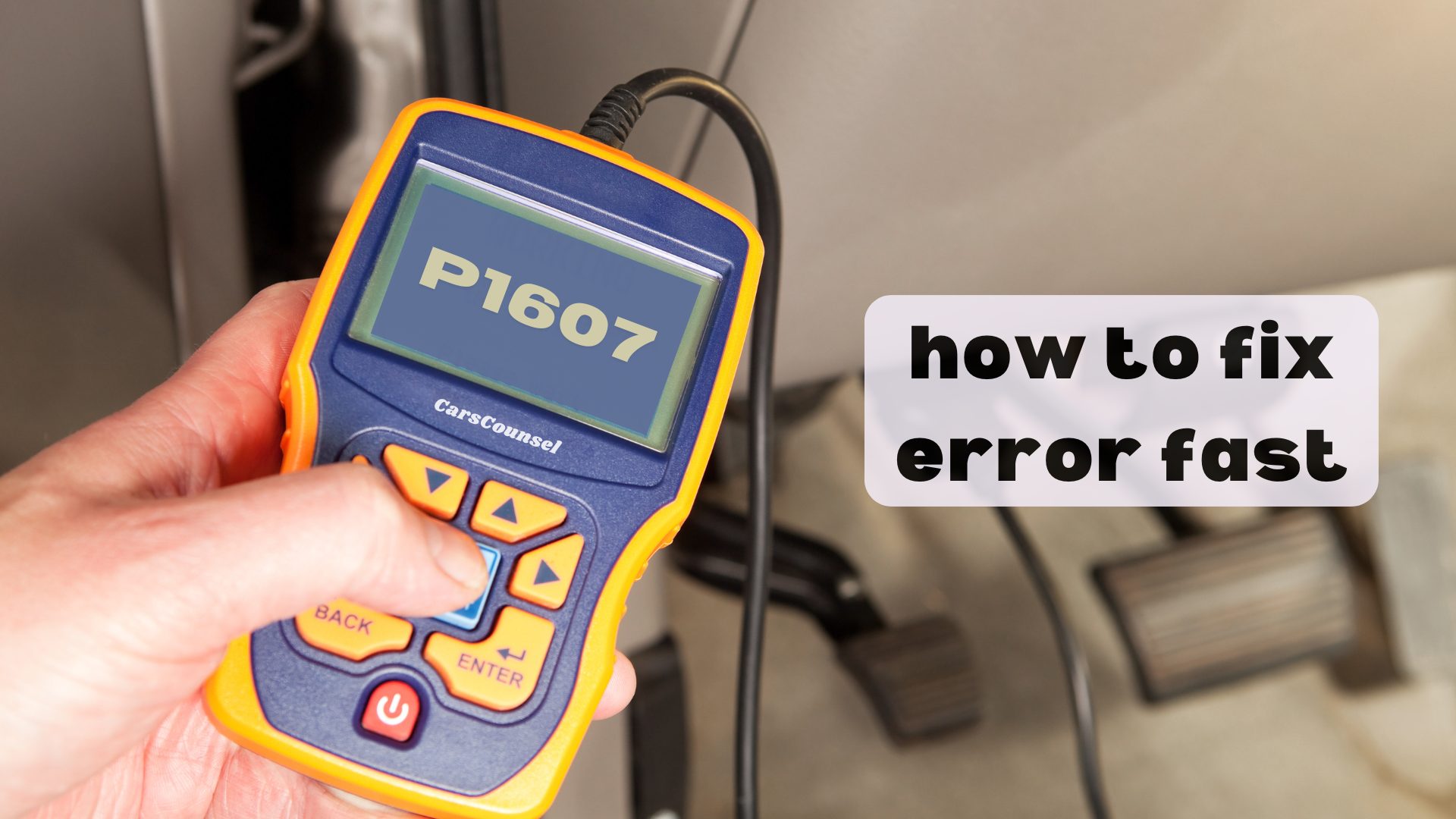Seeing a P1607 code can be annoying, but you can fix it quickly if you know what to do.
First, connect an OBD-II scanner to confirm the error code and find out what’s wrong. This code usually means there’s an issue with the engine control module (ECM), like a software glitch or a sensor problem.
Knowing these possible causes is key to fixing the issue effectively.
So, what should you do to address this code quickly and avoid more engine problems?
Let’s look at the best ways to solve it fast.

Quick Navigation
Key Takeaways
- Look for and fix any loose or rusty electrical connections to the ECM.
- Make sure the battery voltage and charging system are working properly.
- Update or reprogram the ECM software to the latest version from the manufacturer.
- Replace any broken sensors, like the TPS, MAF, or CKP, that impact the ECM.
Understanding the P1607 Code
Understanding the P1607 code means knowing it signals a problem with the engine control module (ECM). This is a big deal because the ECM controls key engine functions.
When this code pops up, it usually turns on the Check Engine Light (CEL) to let you know something’s wrong.
To fix the issue, you need to use an OBD-II scanner to get the diagnostic trouble codes (DTCs). Look at the wiring and connectors for any damage or rust since these are common problems.
Also, make sure the ECM has the latest software updates or has been reprogrammed if needed.
Importance of Addressing P1607
Fixing the P1607 code right away is important to avoid engine problems and keep your car running well. If you ignore it, you could end up with major issues like a failing engine control module (ECM) and unpredictable engine behavior.
Over time, this can mean worse gas mileage, more pollution, and eventually, a completely broken engine. By taking care of this issue quickly, you ensure that your car’s computer works properly and keeps the engine in top shape.
Putting off repairs can make things worse and lead to more expensive fixes. To prevent these problems, use the right diagnostic tools to find the issue accurately and fix it as soon as possible.
This way, you help your car last longer and stay reliable.
Common Causes of P1607
To fix the P1607 code and avoid more problems, it’s important to find out what’s causing it.
Common reasons include bad electrical connections, software issues, low battery voltage, faulty sensors, and internal problems with the ECM/TCM. Fixing these can make your car run better. You’ll need diagnostic tools to figure out the exact issue.
Here are some common causes to keep an eye on:
- Loose or damaged electrical connections: These can mess up communication with the ECM.
- Software problems: These can stop the ECM/TCM from working properly.
- Low battery voltage: A weak battery can set off this code.
- Bad sensors: Problems with sensors like the TPS, MAF, or CKP can affect ECM performance.
Electrical Connection Issues
A common cause of the P1607 code is loose or damaged electrical connections, which can mess up communication between the ECM and other car parts.
To fix this, start by checking all the wiring thoroughly. Look for any signs of rust, wear, or loose connections in the wiring harnesses. Pay special attention to the ECM connectors and make sure they’re plugged in properly.
It’s important to keep these connections in good shape; clean any rusty terminals and fix or replace any damaged wires. Use a multimeter to check that the wires are working right and sending signals correctly.
Regularly check and maintain these connections to avoid future problems. By doing these steps, you’ll improve ECM communication and help fix the P1607 code effectively.
Software Problems in ECM
Software issues in the ECM can mess up communication with different parts of your car, causing the P1607 code to pop up. These issues often come from outdated or corrupted ECM software. Keeping your ECM software up-to-date is key to keeping your car running well.
Here’s what you should do:
- Check for Software Updates: Regularly see if your car’s manufacturer has any new ECM software updates.
- Reprogram the ECM: If there are updates, reprogram the ECM to make sure it talks correctly with other parts.
- Diagnose with OBD-II Tools: Use diagnostic tools to find software problems in the ECM.
- Consult a Professional: If you’re unsure, ask a professional mechanic for help with ECM programming.
Low Battery Voltage Impact
How does low battery voltage affect your car’s performance and trigger the P1607 code? Low battery voltage messes with the ECM’s (Engine Control Module) functionality, causing communication errors that trigger the P1607 code. Keeping your battery in good shape and monitoring its voltage is crucial to avoid such problems. A weak battery or a faulty charging system can cause uneven voltage, making it hard for the ECM to manage engine operations properly.
| Symptom | Cause | Solution |
|---|---|---|
| Check Engine Light | Low battery voltage | Test and replace the battery |
| Poor engine start | Insufficient charge | Inspect the charging system |
| Inconsistent idle | Voltage fluctuation | Monitor and stabilize voltage |
| Diagnostic errors | ECM communication issues | Ensure proper voltage levels |
Regularly check your battery’s health to keep your car running smoothly.
Sensor Malfunctions
Switching focus from battery problems, sensor issues can also set off the P1607 code by messing with the ECM’s ability to keep an eye on and control the engine properly.
If sensors like the Throttle Position Sensor (TPS), Mass Air Flow (MAF), or Crankshaft Position (CKP) aren’t working right, the ECM gets bad info, leading to performance problems.
To fix this:
- Sensor Calibration: Make sure all sensors are properly calibrated to give accurate data.
- Sensor Replacement: Swap out bad sensors to get the ECM back on track.
- Inspect Wiring: Look over the sensor wiring for any damage or rust that might mess up signals.
- Regular Maintenance: Stay on top of regular vehicle checks to catch sensor problems early.
Doing these things is key to keeping your vehicle running well and avoiding the P1607 code.
Internal ECM Faults
Internal ECM problems often come from hardware issues within the engine control module, which can mess up its ability to manage engine functions properly. It’s important to fix these problems quickly to avoid more engine trouble.
Start by thoroughly testing the module to find any internal issues. If the tests show that the ECM is faulty, you might need to replace it to get everything running smoothly again. Make sure to use a verified replacement that fits your vehicle’s specifications.
When swapping out the ECM, follow the manufacturer’s instructions carefully to avoid any more problems. Accurate testing and the right ECM replacement are key steps to fixing the P1607 code fast and effectively. Acting quickly will help keep your vehicle running at its best.
Diagnostic Steps for P1607
Steps to Diagnose the P1607 Code
- Connect a Scanner: Hook up an OBD-II scanner to find the P1607 code and any other related codes.
- Check the Wiring: Look over all the wiring and connectors to make sure they aren’t damaged or corroded.
- Update the Software: Ensure the ECM (Engine Control Module) has the latest software and update it if needed.
- Test Parts: Run continuity tests on sensors and relays to make sure they’re sending signals correctly.
- Check the Battery: Make sure the battery voltage and the charging system are working properly.
Effective Repair Strategies
To fix the P1607 code effectively, you should start by addressing any faulty sensors, damaged electrical connections, outdated software in the ECM/TCM, and weak battery or charging systems.
Use an OBD-II scanner to identify the code and related problems. Replace malfunctioning sensors like the TPS, MAF, or CKP.
Check and repair any damaged wiring or connectors to ensure good communication between modules. Update or reprogram the ECM/TCM software if it’s old.
Make sure the battery and charging system are working properly. Finally, clear any error codes and take the car for a test drive.
To avoid future issues, perform regular diagnostics and keep the software up to date.
More OBD-II Codes
Frequently Asked Questions
Can P1607 Code Affect My Vehicle’s Fuel Efficiency?
Yes, the P1607 code can affect your vehicle’s fuel efficiency. Use diagnostic tools to find the exact problem. Fixing issues with the engine control module (ECM) or faulty sensors can help your engine run better and improve fuel efficiency.
How Much Does It Typically Cost to Repair a P1607 Code Issue?
Fixing a P1607 code can cost different amounts depending on several factors. You’ll need to consider the cost of diagnosing the problem, the price of any parts that need replacing, and the labor involved. Typically, you might spend anywhere from $100 to $1,000, depending on what’s wrong and what kind of car you have.
Is It Safe to Drive With a P1607 Error Code?
Driving with a P1607 error code isn’t safe. It affects how well your car runs and can make driving dangerous. You should get it checked and fixed right away. Ignoring it can cause serious engine problems and might leave you stuck on the side of the road. So, don’t wait—get it repaired as soon as possible.
Can Aftermarket Parts Cause a P1607 Code to Appear?
Yes, using aftermarket parts can cause a P1607 code to show up. Make sure the parts you choose are compatible with your vehicle because the wrong ones can mess up sensors and affect how the Engine Control Module (ECM) communicates. Always check that the parts meet the right specs to prevent error codes from popping up.
How Long Does It Take to Diagnose and Fix a P1607 Code?
How long does it take to diagnose and fix a P1607 code? With the right tools and methods, you can usually figure out and fix the problem in a few hours, depending on how complicated it is.
Conclusion
Fixing the P1607 code is like untangling a knot.
Quickly use an OBD-II scanner, check the wiring, update the ECM software, and inspect important sensors to get your car running smoothly again.
Don’t wait; each step ensures your engine works well and avoids more problems.
Acting fast and carefully keeps your car’s engine control module in good shape.

